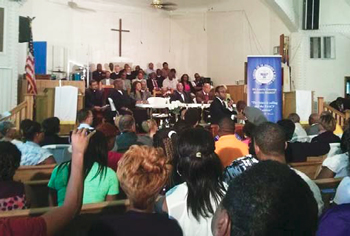Our youth: riot or rebellion?
By A.Akbar Muhammad | Last updated: Aug 23, 2014 - 7:06:22 PMWhat's your opinion on this article?

|

NAACP St. Louis County town hall meeting. Photo: Facebook.com
What must be understood is “rebellions” and “riots” are two different things. In Ferguson people don’t feel a sense of justice and the execution style murder of Michael Brown is the latest in a list of events against the Black community. |
The meeting was one of many held since the August 9 shooting death of the 18-year-old college freshman who friends called “Big Mike” and would have been starting his first semester days later if he was not slain.
This was not a meeting to talk about looting and condemning young people; but a meeting and rally to discuss the vile cold blooded murder of one of our children by a White policeman and the twisted story circulated throughout the world saying “Big Mike” was shot attempting to take the officer’s weapon.
This is not about young men needing more education; being more responsible or lacking a sense of family as one White person at the meeting asserted.
Some speakers couched their comments in such condescending terms towards Black youth who took to the streets in the aftermath. They emphasized socializing Black youth to be better “citizens” to avoid such situations with law enforcement. It was as if they were playing to the national media covering the story.
I thank Berkeley, MO. Mayor Ted Hoskins whose words brought the meeting back on the right course.
“This is not complex,” said Mayor Hoskins. “One person died. One person was shot. If you let them tell you how complex this is, you’re going to miss the point. If you don’t have education, that does not make the police shoot you….”
“You don’t forgive this because if you forgive this, you are next,” Mayor Hoskins continued.
For some speakers, guiding “wayward youth” became the safer message than discussing the excessive militarization of local police forces and apartheid like attitudes from majority White police forces toward policing non-White communities. Looting became the safer message than discussing the legitimate weariness of a community beset by repressive socio-economic disparities and general disrespect by law enforcement.
It was very painful to listen to them express their bankrupt thinking. Perhaps some of the more patronizing speakers suffer the mental illness of self-hatred that made it easy for them to get bull-baited into condemning Black youth and adults who didn’t cause the unrest. In their self-hatred they needed to tell the press and White authorities that, “we’re alright; these were some reckless, irresponsible thugs who looted, burned and fought back the police.” We are the “responsible” leadership.
What must be understood is “rebellions” and “riots” are two different things. In Ferguson people don’t feel a sense of justice and the execution style murder of Michael Brown is the latest in a list of events against the Black community.
When there is constantly no justice and an unarmed person is shot multiple times to death, then left laying in the street like an animal for 4 hours, then the effects on property in the reaction is collateral damage. Businesses can rebuild; but for Michael Brown, there is no coming back.
The anger in the streets wasn’t a riot, it was a rebellion. Sustained injustice produced an underclass in America—people who feel trapped, hopeless and feel they have nothing to live for. It was an opportunity to advance among them an idea of a better way, not condemn them. It is an opportunity to challenge America for its role in the condition of its Black, Brown and poor people.
Should some of us who are more sophisticated and were able to advance, look down our noses on the masses in the ghettos that are America’s underclass? Are we sending a signal to the White authorities to go on and kill our people because they’re “just” an underclass and maybe they deserve it?
We cannot send that signal. We have to hold out hope because these are our young people. So as I sat there, I did something unprecedented for me and passed a note to allow me to say a word to set some balance to the leaders who continued to berate our youth, which was rejected.
But when they allowed audience participation, the community people unequivocally gave the meeting the balance it needed in the face of very out of touch “leadership.”
The question is, for our youth; was this a riot or a rebellion against the condition that they feel hopeless and trapped in?
(A. Akbar Muhammad can be reached at [email protected])
INSIDE STORIES AND REVIEWS
-
-
About Harriett ... and the Negro Hollywood Road Show
By Rabiah Muhammad, Guest Columnist » Full Story -
Skepticism greets Jay-Z, NFL talk of inspiring change
By Bryan 18X Crawford and Richard B. Muhammad The Final Call Newspaper @TheFinalCall » Full Story -
The painful problem of Black girls and suicide
By Charlene Muhammad -National Correspondent- » Full Story -
Exploitation of Innocence - Report: Perceptions, policies hurting Black girls
By Charlene Muhammad -National Correspondent- » Full Story -
Big Ballin: Big ideas fuel a father’s Big Baller Brand and brash business sense
By Bryan Crawford -Contributing Writer- » Full Story






 Click Here Stay Connected!
Click Here Stay Connected!








